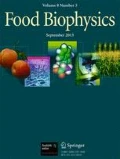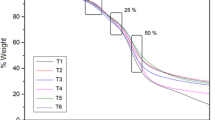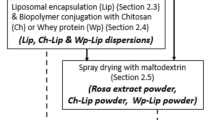Abstract
The limited stability of Spirulina protein extract towards environmental factors limits its application in food formulations. This study evaluates the characteristics and efficacy of different delivery systems composed of pure trehalose and trehalose-maltodextrin mixtures at different ratios (50:50; 20:80) to encapsulate Spirulina extract. The delivery systems were obtained through conventional amorphization techniques as freeze- and spray-drying and novel ones such as co-milling. Among the studied techniques, freeze-dried samples, regardless of the matrix composition, exhibited the highest carrying capacity with a residual amount of phycocyanin >89% after encapsulation. The use of ball co-milling for encapsulation caused a complete degradation of the core compound when applied using processing times applied of 6 h and 12 h. The glass transition temperature of the different samples, determined by differential scanning calorimetry, was affected by the carrier composition, increasing with increasing amounts of maltodextrin present in the matrix. When samples were exposed to high temperature during storage the delivery systems containing maltodextrin were more effective in preventing thermal degradation of the Spirulina extract and preserving its colouring ability.







Similar content being viewed by others
References
M.A. Azevedo, A.I. Bourbon, A.A. Vicente, M.A. Cerqueira, Alginate/chitosan nanoparticles for encapsulation and controlled release of vitamin B2. Int. J. Biol. Macromol. 71, 141–146 (2014)
S. Ersus, U. Yurdagel, Microencapsulation of anthocyanin pigments of black carrot (Daucus carota L.) by spray drier. J. Food Eng. 80(3), 805–812 (2007)
L.S. Jackson, K. Lee, Microencapsulation and the food industry. Lebensm. Wiss. Technol. 24(4), 289–297 (1991)
M. Kfoury, L. Auezova, H. Greige-Gerges, S. Fourmentin, Encapsulation in cyclodextrins to widen the applications of essential oils. Environ. Chem. Lett. 17(1), 129–143 (2019)
C.C. Koga, A.R. Becraft, Y. Lee, S.Y. Lee, Taste detection thresholds of resveratrol. J. Food Sci. 80(9), S2064–S2070 (2015)
Y.H. Roos, Glass transition temperature and its relevance in food processing. Annu. Rev. Food Sci. Technol. 1(1), 469–496 (2010). https://doi.org/10.1146/annurev.food.102308.124139
F. Shahidi, X.Q. Han, Encapsulation of food ingredients. Critical Reviews in Food Science & Nutrition 33(6), 501–547 (1993)
L. Cordone, G. Cottone, A. Cupane, A. Emanuele, S. Giuffrida, M. Levantino, Proteins in saccharides matrices and the Trehalose peculiarity: Biochemical and biophysical properties. Curr. Org. Chem. 19(17), 1684–1706 (2015)
J.M. Lakkis, Encapsulation and controlled release technologies in food systems (John Wiley & Sons, 2008)
M.G. Corradini, in Encyclopedia of Food Chemistry, ed. by L. Melton, F. Shaidi, P. Varelis. Synthetic food colors, vol 1 (Elsevier, New York, 2019), pp. 291–296
D. McCann, A. Barrett, A. Cooper, D. Crumpler, L. Dalen, K. Grimshaw, E. Kitchin, K. Lok, L. Porteous, E. Prince, E. Sonuga-Barke, J.O. Warner, J. Stevenson, Food additives and hyperactive behaviour in 3-year-old and 8/9-year-old children in the community: A randomised, double-blinded, placebo-controlled trial. Lancet 370(9598), 1560–1567 (2007)
F. Gandía-Herrero, M. Jiménez-Atiénzar, J. Cabanes, F. García-Carmona, J. Escribano, Stabilization of the bioactive pigment of Opuntia fruits through maltodextrin encapsulation. J. Agric. Food Chem. 58(19), 10646–10652 (2010)
P. Robert, R. Carlsson, N. Romero, L. Masson, Stability of spray-dried encapsulated carotenoid pigments from rosa mosqueta (Rosa rubiginosa) oleoresin. J. Am. Oil Chem. Soc. 80(11), 1115–1120 (2003)
K. Selim, K. Khalil, M. Abdel-Bary, N. Abdel-Azeim, in Alexandria Journal for Food Science and Technology. Special Volume Conference. Extraction, encapsulation and utilization of red pigments from roselle (Hibiscus sabdariffa L.) as natural food colourants (2008), pp. 7–20
G. Martelli, C. Folli, L. Visai, M. Daglia, D. Ferrari, Thermal stability improvement of blue colorant C-Phycocyanin from Spirulina platensis for food industry applications. Process Biochem. 49(1), 154–159 (2014). https://doi.org/10.1016/j.procbio.2013.10.008
M. Faieta, Technological functionality and stability of colouring foodstuff in confectionery products. 20th workshop on the developments in the Italian PhD research on food science Technology and biotechnology (University of Teramo, 2015)
K. Fukui, T. Saito, Y. Noguchi, Y. Kodera, A. Matsushima, H. Nishimura, et al., Relationship between color development and protein conformation in the phycocyanin molecule. Dyes Pigments 63(1), 89–94 (2004)
P. Pittia, Physcal State of Sugar Matrices and Aroma-Sugars Interactions at Nano-Scale (University of Trieste, Trieste, 2016)
C. Hedlin, Sorption isotherms of five types of grain straw at 70° F. Can. Agric. Eng. 9(1), 37–39 (1967)
M. Lawrence, A. Heath, P. Walker, Determining moisture levels in straw bale construction. Constr. Build. Mater. 23(8), 2763–2768 (2009)
G. Accorsi, G. Verri, M. Bolognesi, et al., The exceptional near-infrared luminescence properties of cuprorivaite (Egyptian blue). Chem. Commun. 23, 3392–3394 (2009). https://doi.org/10.1039/b902563d
A. Patel, S. Mishra, R. Pawar, P. Ghosh, Purification and characterization of C-phycocyanin from cyanobacterial species of marine and freshwater habitat. Protein Expr. Purif. 40(2), 248–255 (2005)
N. Silalai, Y.H. Roos, Mechanical relaxation times as indicators of stickiness in skim milk–maltodextrin solids systems. J. Food Eng. 106(4), 306–317 (2011)
X.C. Tang, M.J. Pikal, Design of freeze-drying processes for pharmaceuticals: Practical advice. Pharm. Res. 21(2), 191–200 (2004)
P.L. Privalov, Cold denaturation of protein. Crit. Rev. Biochem. Mol. Biol. 25(4), 281–306 (1990)
T. Arakawa, S.J. Prestrelski, W.C. Kenney, J.F. Carpenter, Factors affecting short-term and long-term stabilities of proteins. Adv. Drug Deliv. Rev. 46(1), 307–326 (2001)
A. Hedoux, L. Paccou, S. Achir, Y. Guinet, Mechanism of protein stabilization by trehalose during freeze-drying analyzed by in situ micro-raman spectroscopy. J. Pharm. Sci. 102(8), 2484–2494 (2013)
R. Sarada, M.G. Pillai, G. Ravishankar, Phycocyanin from Spirulina sp: Influence of processing of biomass on phycocyanin yield, analysis of efficacy of extraction methods and stability studies on phycocyanin. Process Biochem. 34(8), 795–801 (1999)
F. Gibbs, S. K., Inteaz Alli, Catherine N. Mulligan, Bernard (1999). Encapsulation in the food industry: A review. Int. J. Food Sci. Nutr., 50(3), 213–224
M.T.M. Gomes, D.T. Santos, M.A.A. Meireles, Micronization and encapsulation: Application of supercritical fluids in water removal. Conventional and Advanced Food Processing Technologies 249-266 (2015). https://doi.org/10.1002/9781118406281.ch11
F. Sussich, A. Cesàro, Trehalose amorphization and recrystallization. Carbohydr. Res. 343(15), 2667–2674 (2008)
J. Willart, A. De Gusseme, S. Hemon, G. Odou, F. Danede, M. Descamps, Direct crystal to glass transformation of trehalose induced by ball milling. Solid State Commun. 119(8), 501–505 (2001)
M.P. Te Booy, R.A. De Ruiter, A.L. De Meere, Evaluation of the physical stability of freeze-dried sucrose-containing formulations by differential scanning calorimetry. Pharm. Res. 9(1), 109–114 (1992)
Y. Roos, M. Karel, Plasticizing effect of water on thermal behavior and crystallization of amorphous food models. J. Food Sci. 56(1), 38–43 (1991b)
S.A. Desobry, F.M. Netto, T.P. Labuza, Comparison of spray-drying, drum-drying and freeze-drying for β-carotene encapsulation and preservation. J. Food Sci. 62(6), 1158–1162 (1997)
R. Surana, A. Pyne, R. Suryanarayanan, Effect of preparation method on physical properties of amorphous trehalose. Pharm. Res. 21(7), 1167–1176 (2004)
V. Sanchez, R. Baeza, M.V. Galmarini, M.C. Zamora, J. Chirife, Freeze-drying encapsulation of red wine polyphenols in an amorphous matrix of maltodextrin. Food and Bioprocess Technol. 6(5), 1350–1354 (2013). https://doi.org/10.1007/s11947-011-0654-z
Wang W, Zhou WJF & Technology B (2013) Water adsorption and glass transition of spray-dried soy sauce powders using maltodextrins as carrier. 6(10), 2791-2799
T.G. Fox Jr., P.J. Flory, Second-order transition temperatures and related properties of polystyrene. I. Influence of molecular weight. J. Appl. Phys. 21(6), 581–591 (1950)
Y. Roos, M. Karel, Phase transitions of mixtures of amorphous polysaccharides and sugars. Biotechnol. Prog. 7(1), 49–53 (1991a)
K. Zeleznak, R. Hoseney, The glass transition in starch. Cereal Chem. 64(2), 121–124 (1987)
M. Descamps, J. Willart, E. Dudognon, V. Caron, Transformation of pharmaceutical compounds upon milling and comilling: The role of Tg. J. Pharm. Sci. 96(5), 1398–1407 (2007)
M. Cano-Chauca, P. Stringheta, A. Ramos, J. Cal-Vidal, Effect of the carriers on the microstructure of mango powder obtained by spray drying and its functional characterization. Innovative Food Sci. Emerg. Technol. 6(4), 420–428 (2005)
N. Jovanović, A. Bouchard, G.W. Hofland, G.-J. Witkamp, D.J. Crommelin, W. Jiskoot, Distinct effects of sucrose and trehalose on protein stability during supercritical fluid drying and freeze-drying. Eur. J. Pharm. Sci. 27(4), 336–345 (2006)
R. Lefort, A. De Gusseme, J.-F. Willart, F. Danede, M. Descamps, Solid state NMR and DSC methods for quantifying the amorphous content in solid dosage forms: An application to ball-milling of trehalose. Int. J. Pharm. 280(1), 209–219 (2004)
P. Dawson, D. Hockley, Scanning electron microscopy of freeze-dried preparations: Relationship of morphology to freeze-drying parameters. Dev. Biol. Stand. 74, 185–192 (1991)
S. Devi, D. Williams, Morphological and compressional mechanical properties of freeze-dried mannitol, sucrose, and Trehalose cakes. J. Pharm. Sci. 102(12), 4246–4255 (2013)
M. Bruschi, M. Cardoso, M. Lucchesi, M. Gremião, Gelatin microparticles containing propolis obtained by spray-drying technique: Preparation and characterization. Int. J. Pharm. 264(1), 45–55 (2003)
J. Loksuwan, Characteristics of microencapsulated β-carotene formed by spray drying with modified tapioca starch, native tapioca starch and maltodextrin. Food Hydrocoll. 21(5), 928–935 (2007)
Z.-Y. Zhang, Q.-N. Ping, B. Xiao, Microencapsulation and characterization of tramadol–resin complexes. J. Control. Release 66(2), 107–113 (2000)
N.T. Eriksen, Production of phycocyanin—A pigment with applications in biology, biotechnology, foods and medicine. Appl. Microbiol. Biotechnol. 80(1), 1–14 (2008)
V. Stadnichuk, E. Lukashev, M. Yanyushin, D. Zlenko, E. Muronez, I. Stadnichuk, et al., in Doklady Biochemistry and Biophysics. Energy transfer pathways among phycobilin chromophores and fluorescence emission spectra of the phycobilisome core at 293 and 77 K, vol 465 (Springer, 2015), pp. 401–405, Vol. 1
C. Toong, Understanding Thermal Stability and Environmental Sensitivity of Phycocyanin Using Spectroscopic and Modelling Tools (University of Massachusetts, Amherst, MSc Thesis, 2018)
B.C. Hancock, C.R. Dalton, The effect of temperature on water vapor sorption by some amorphous pharmaceutical sugars. Pharm. Dev. Technol. 4(1), 125–131 (1999)
V. Maidannyk, B. Nurhadi, Y. Roos, Structural strength analysis of amorphous trehalose-maltodextrin systems. Food Res. Int. 96, 121–131 (2017)
D. Van Drooge, W. Hinrichs, H. Frijlink, Incorporation of lipophilic drugs in sugar glasses by lyophilization using a mixture of water and tertiary butyl alcohol as solvent. J. Pharm. Sci. 93(3), 713–725 (2004)
A. Saleki-Gerhardt, G. Zografi, Non-isothermal and isothermal crystallization of sucrose from the amorphous state. Pharm. Res. 11(8), 1166–1173 (1994)
L.S. Taylor, Carbohydrates as Protein Stabilizing Agents (University of Bradford, 1996)
S. Brunauer, P.H. Emmett, E. Teller, Adsorption of gases in multimolecular layers. J. Am. Chem. Soc. 60(2), 309–319 (1938)
M.A. Righetto, M.F. Netto, Effect of encapsulating materials on water sorption, glass transition and stability of juice from immature acerola. Int. J. Food Prop. 8(2), 337–346 (2005)
T.P. Labuza, Moisture sorption: Practical aspects of isotherm measurement and use. Mol. Nutr. Food Res. 29(1), 92–92 (1985)
E. Tsami, D. Marinos-Kouris, Z. Maroulis, Water sorption isotherms of raisins, currants, figs, prunes and apricots. J. Food Sci. 55(6), 1594–1597 (1990)
P. Belton, A. Gil, IR and Raman spectroscopic studies of the interaction of trehalose with hen egg white lysozyme. Biopolymers 34(7), 957–961 (1994)
J.F. Carpenter, J.H. Crowe, An infrared spectroscopic study of the interactions of carbohydrates with dried proteins. Biochemistry 28(9), 3916–3922 (1989)
W. Hinrichs, M. Prinsen, H. Frijlink, Inulin glasses for the stabilization of therapeutic proteins. Int. J. Pharm. 215(1), 163–174 (2001)
M. Kupka, H. Scheer, Unfolding of C-Phycocyanin followed by loss of non-covalent chromophore–protein interactions: 1. Equilibrium experiments. Biochimica et Biophysica Acta (BBA)-Bioenergetics 1777(1), 94–103 (2008)
M.A. Mensink, H.W. Frijlink, K. van der Voort Maarschalk, W.L. Hinrichs, How sugars protect proteins in the solid state and during drying (review): Mechanisms of stabilization in relation to stress conditions. Eur. J. Pharm. Biopharm 114, 288–295 (2017)
A. Tigerström, The Biologist's forum: Thermostability of proteins. Bios 76(1), 22–27 (2005)
L.M. Crowe, Lessons from nature: The role of sugars in anhydrobiosis. Comp. Biochem. Physiol. A Mol. Integr. Physiol. 131(3), 505–513 (2002)
Estupiñan D, Schwartz S & Garzón GJJofs (2011) Antioxidant activity, total phenolics content, anthocyanin, and color stability of isotonic model beverages colored with Andes berry (Rubus glaucus Benth) anthocyanin powder. 76(1), S26-S34
M.V. Galmarini , C. Maury, E. Mehinagic, et al., Stability of individual phenolic compounds and antioxidant activity during storage of a red wine powder. Food Bioprocess Technol. 6(12), 3585-3595 (2013). https://doi.org/10.1007/s11947-012-1035-y
C. Osorio, B. Acevedo, S. Hillebrand, J. Carriazo, P. Winterhalter, M.A.L. JJoA, F. Chemistry, Microencapsulation by spray-drying of anthocyanin pigments from corozo. (Bactris guineensis) fruit 58(11), 6977–6985 (2010)
N. Grasmeijer, M. Stankovic, H. de Waard, H.W. Frijlink, W.L. Hinrichs, Unraveling protein stabilization mechanisms: Vitrification and water replacement in a glass transition temperature controlled system. Biochimica et Biophysica Acta (BBA)-Proteins and Proteomics 1834(4), 763–769 (2013)
M.A. Mensink, P.-J. Van Bockstal, S. Pieters, L. De Meyer, H.W. Frijlink, K. van der Voort Maarschalk, et al., In-line near infrared spectroscopy during freeze-drying as a tool to measure efficiency of hydrogen bond formation between protein and sugar, predictive of protein storage stability. Int. J. Pharm. 496(2), 792–800 (2015)
Author information
Authors and Affiliations
Corresponding authors
Additional information
Publisher’s Note
Springer Nature remains neutral with regard to jurisdictional claims in published maps and institutional affiliations.
Electronic supplementary material
ESM 1
(DOCX 156 kb)
Rights and permissions
About this article
Cite this article
Faieta, M., Corradini, M.G., Di Michele, A. et al. Effect of Encapsulation Process on Technological Functionality and Stability of Spirulina Platensis Extract. Food Biophysics 15, 50–63 (2020). https://doi.org/10.1007/s11483-019-09602-1
Received:
Accepted:
Published:
Issue Date:
DOI: https://doi.org/10.1007/s11483-019-09602-1




